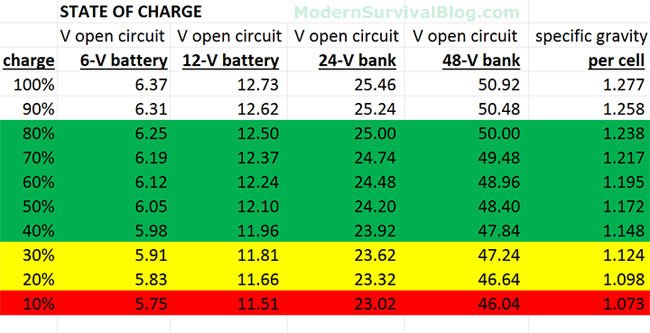Dougcole
Guru
Hi All,
I've been a bit suspicious of the readings I am getting on my Victropn BMV 700 SOC monitor. I have 6 6V FLA GC batteries for my house bank, wired in series and parallel. They are rated at 220 AH each (660 AH total for the bank), but I set my monitor at 600 AH when I replaced them to allow for a little leeway. The bank is 2.5 years old, so last year I adjusted the AH total on my SOC down to 550 AH.
I typically keep the monitor set on % of charge. If I get down to around 60% or so, I charge up the batteries by running the gen-set but I usually don't have to do this as we run the motors or use the gen-set for something else (cooking or AC) which keeps the bank up.
Lately though, I have been noticing the percentage drops really quickly. Last weekend we were on the hook for a few days and I was hitting the 60% mark in about 5 hours. I found this alarming, so I started watching my amp draw. Over the course of a few hours at no point did I see the draw exceed 8a, most of the time it was around 5a.
This was mid day, basically just running the two fridges and a few small things like the FW pump and the head. I'm sure there were spikes when the fridge compressors or the head pump kicked on, but those are pretty short lived.
So last night here at the dock I turned off the battery charger and left it off over night (8 hours). Fridges, head, fw pump on, some lights lights on for a little while. Got up this morning expecting to see 55% or so but nope; 96%. Put my multi meter (a good quality fluke) directly on the batteries and got a reading of 12.4 V. Check the SOC monitor and it is reading 12.39V.
I'm flummoxed. Isn't 12.39 V about a 50% charge? And if I was only drawing 5 or 6 amps for 5 hours how was I going through about 240 AH of battery use?
Should I pay more attention to the voltage charge and less to the % charge?
I've been a bit suspicious of the readings I am getting on my Victropn BMV 700 SOC monitor. I have 6 6V FLA GC batteries for my house bank, wired in series and parallel. They are rated at 220 AH each (660 AH total for the bank), but I set my monitor at 600 AH when I replaced them to allow for a little leeway. The bank is 2.5 years old, so last year I adjusted the AH total on my SOC down to 550 AH.
I typically keep the monitor set on % of charge. If I get down to around 60% or so, I charge up the batteries by running the gen-set but I usually don't have to do this as we run the motors or use the gen-set for something else (cooking or AC) which keeps the bank up.
Lately though, I have been noticing the percentage drops really quickly. Last weekend we were on the hook for a few days and I was hitting the 60% mark in about 5 hours. I found this alarming, so I started watching my amp draw. Over the course of a few hours at no point did I see the draw exceed 8a, most of the time it was around 5a.
This was mid day, basically just running the two fridges and a few small things like the FW pump and the head. I'm sure there were spikes when the fridge compressors or the head pump kicked on, but those are pretty short lived.
So last night here at the dock I turned off the battery charger and left it off over night (8 hours). Fridges, head, fw pump on, some lights lights on for a little while. Got up this morning expecting to see 55% or so but nope; 96%. Put my multi meter (a good quality fluke) directly on the batteries and got a reading of 12.4 V. Check the SOC monitor and it is reading 12.39V.
I'm flummoxed. Isn't 12.39 V about a 50% charge? And if I was only drawing 5 or 6 amps for 5 hours how was I going through about 240 AH of battery use?
Should I pay more attention to the voltage charge and less to the % charge?

